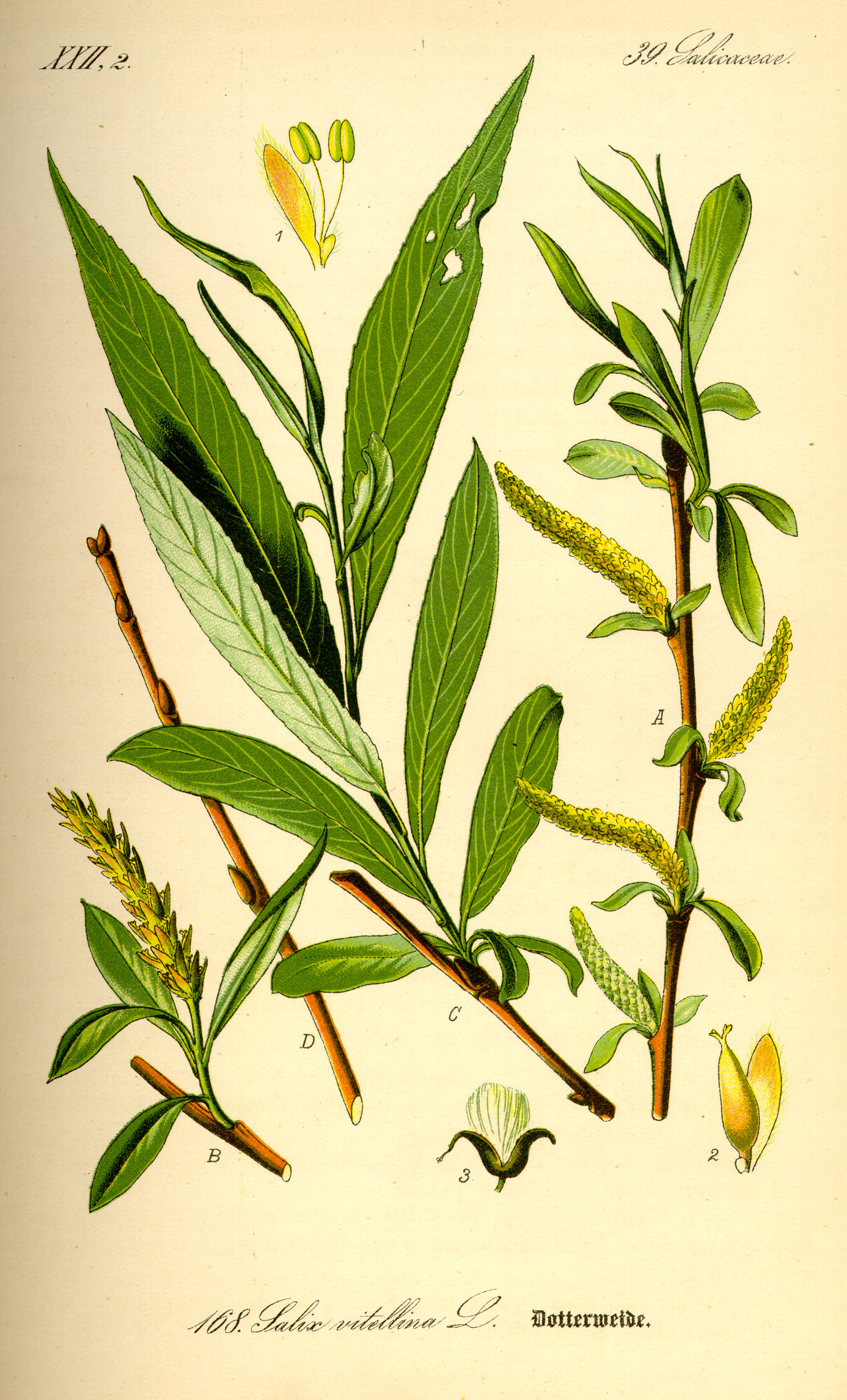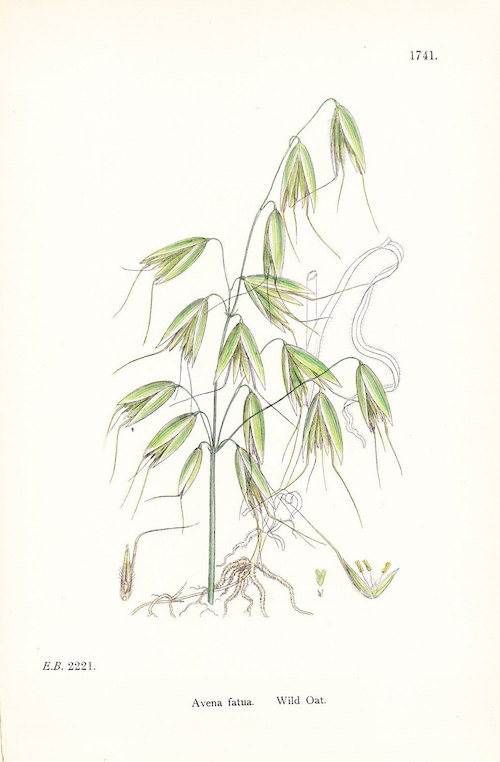Dr Clare Materia Medica
Introduction to the Dispensing of Dr Clare’s Blended Herbs
Special | A | B | C | D | E | F | G | H | I | J | K | L | M | N | O | P | Q | R | S | T | U | V | W | X | Y | Z | ALL
W |
|---|
WHITE WILLOW
Basket Willow, Bay Willow, Black Willow, Black Willowbark, Black Willow Extract, European Willow Bark. Scientific Name: Salix alba; other Salix species. Family: Salicaceae. People Use This For: Willow bark is used for headache, pain, muscle pain, osteoarthritis, painful periods, gouty arthritis, ankylosing spondylitis, rheumatoid arthritis, and gout. It is also used for fever, common cold, and influenza. Safety: No concerns regarding safety when used orally and appropriately, short-term.19,20,21,22,23 Willow bark has been used safely for up to 13 weeks in one study.23
Children: Possibly Unsafe.24 Although Reye's syndrome has not been reported, the salicin constituent in willow bark is similar to aspirin and might pose the same risk. Pregnancy and Breastfeeding: Consult a Medical Herbalist. Effectiveness: POSSIBLY EFFECTIVE Back pain. There's some evidence that a willow bark extract providing 120-240mg of the salicin constituent daily can reduce low back pain in some patients. The higher concentration of 240mg salicin is more effective than 120mg of salicin. It can take up to 1 week for significant relief.19 Some research suggests salicin 240mg daily is as effective as rofecoxib (Vioxx) for low back pain.22 INSUFFICIENT RELIABLE EVIDENCE to RATE Osteoarthritis. Clinical research on willow bark extract for osteoarthritis is conflicting. Some research suggests it has a moderate analgesic effect on osteoarthritis, while other research shows it is similar to placebo and inferior to diclofenac (Voltaren, Cataflam).20,21 Rheumatoid arthritis (RA). Preliminary clinical research suggests that willow bark extract is not effective for rheumatoid arthritis.21 More evidence is needed to rate willow bark for these uses. Mechanism of Action: Willow bark is the bark of salix tree species such as the white willow. Willow bark constituents include flavonoids, tannins, and salicylates. The active constituent of willow bark is thought to be salicin. Salicin is metabolized to salicyl alcohol and then to salicylic acid. From there, metabolism is the same as aspirin.25 An ethanolic extract of willow bark seems to inhibit cyclooxygenase (COX)-2 mediated prostaglandin release, but it doesn't seem to directly affect COX-1 or COX-2 activity. Constituents of willow bark other than salicin may have lipoxygenase-inhibiting and antioxidant effects that could contribute to its analgesic effect.19,26 They also might prevent prostaglandin and cytokine release.26 Some research suggests that extended treatment with willow bark may be necessary for a therapeutic effect.27,28 Preliminary research suggests that willow bark extracts have analgesic, anti-inflammatory, and antipyretic effects.26 Willow bark inhibits platelet aggregation, but to a lesser degree than aspirin.29 Bioavailability of willow bark may be lower due to manufacturing processes. A dose of 240mg of salicin is equivalent to 87mg of aspirin.25 Adverse Reactions: Willow bark extract can cause gastrointestinal adverse effects, but these appear to be less frequent than those caused by NSAIDs.20,21 Willow bark may cause itching and rash, as well as serious allergic reactions, including anaphylaxis, in people who are allergic to aspirin.30,20,21 Salicylates can inhibit prostaglandins, which can reduce renal blood flow.31 Salicin can cause renal papillary necrosis.32 The risk for toxicity is greater with high acute doses or chronic use.31 Interactions with Herbs & Supplements: Anticoagulant/Antiplatelet Herbs and Supplements: Concomitant use of herbs that have antiplatelet/anticoagulant effects could theoretically increase the risk of bleeding in some people.29 These herbs include clove, danshen, garlic, ginger, ginkgo, ginseng, meadowsweet, red clover, and others. Salicylate-Containing Herbs: Theoretically, concomitant use may potentiate salicylate effects and adverse effects.25 Salicylate-containing herbs include aspen bark, black haw, poplar, and meadowsweet. Interactions with Drugs: Warfarin: Absolute contraindication. Aspirin: Willow bark contains salicin, a plant salicylate. Theoretically, willow bark might have an additive effect with other salicylate-containing drugs such as aspirin.25 Choline Magnesium Trisalicylate (Trilisate): Interaction Rating = Moderate Be cautious with this combination. Severity = Moderate. Occurrence = Probable. Willow bark contains salicin, a plant salicylate. Theoretically, willow bark might have an additive effect with other salicylate-containing drugs such as choline magnesium trisalicylate.25 Salsalate (Disalcid): Interaction Rating = Moderate Be cautious with this combination. Severity = Moderate. Occurrence = Probable. Willow bark contains salicin, a plant salicylate. Theoretically, willow bark might have an additive effect with other salicylate-containing drugs such as salsalate.25 Interactions with Foods: None known. Interactions with Lab Tests: Creatinine: Theoretically, salicin could cause a rise in serum creatinine without affecting renal function. Salicylates can cause a rise in serum creatine without a change in glomerular filtration rate (GFR). This is thought to be due to changes in plasma protein binding caused by salicylates or competitive inhibition of tubular secretion of creatinine by salicylates.33 Interactions with Diseases or Conditions: Kidney Dysfunction: Theoretically, salicin might reduce renal blood flow.31 Chronic use of high doses might contribute to renal failure in predisposed people.32 Avoid use in people with compromised renal function. Salicylate Precautions: Avoid or use cautiously in individuals with aspirin hypersensitivity, asthma, active peptic ulcer disease, diabetes, gout, hemophilia, hypoprothrombinemia, kidney or liver disease. Willow bark may cause serious allergic reactions, including anaphylaxis, in people who are allergic to aspirin.30 Surgery: discontinue willow bark at least 2 weeks before elective surgical procedures. Dosage/Administration: Dr Clare’s Blend: 700mgs/day Oral: For back pain, willow bark extract providing 120-240mg salicin has been used. The higher 240mg dose might be more effective.19,22 Specific References: WHITE WILLOW 19. Chrubasik S, Eisenberg E, Balan E, et al. Treatment of low back pain exacerbations with willow bark extract: a randomized double-blind study. Am J Med 2000;109:9-14. 20. Schmid B, Ludtke R, Selbmann HK, et al. Efficacy and tolerability of a standardized willow bark extract in patients with osteoarthritis: randomized placebo-controlled, double blind clinical trial. Phytother Res 2001;15:344-50. 21. Biegert C, Wagner I, Ludtke R, et al. Efficacy and safety of willow bark extract in the treatment of osteoarthritis and rheumatoid arthritis: results of 2 randomized double-blind controlled trials. J Rheumatol 2004;31:2121-30. 22. Chrubasik S, Kunzel O, Model A, et al. Treatment of low back pain with a herbal or synthetic anti-rheumatic: a randomized controlled study. Willow bark extract for low back pain. Rheumatology (Oxford) 2001;40:1388-93. 23. Coffey CS, Steiner D, Baker BA, Allison DB. A randomized double-blind placebo-controlled clinical trial of a product containing ephedrine, caffeine, and other ingredients from herbal sources for treatment of overweight and obesity in the absence of lifestyle treatment. Int J Obes Relat Metab Disord 2004;28:1411-9. 24. Food and Drug Administration, HHS. Labeling for oral and rectal over-the-counter drug products containing aspirin and nonaspirin salicylates; Reye's Syndrome warning. Final rule. Fed Regist 2003;18:18861-9. 25. Schmid B, Kotter I, Heide L. Pharmacokinetics of salicin after oral administration of a standardised willow bark extract. Eur J Clin Pharmacol. 2001;57:387-91. 26. Fiebich BL, Chrubasik S. Effects of an ethanolic salix extract on the release of selected inflammatory mediators in vitro. Phytomedicine 2004;11:135-8. 27. Wagner I, Greim C, Laufer S, et al. Influence of willow bark extract on cyclooxygenase activity and on tumor necrosis factor alpha or interleukin 1 beta release in vitro and ex vivo. Clin Pharmacol Ther 2003;73:272-14. 28. Fiebich BL, Appel K. Anti-inflammatory effects of willow bark extract. Clin Pharmacol Ther 2003;74:96. 29. Krivoy N, Pavlotzky E, Chrubasik S, et al. Effect of salicis cortex extract on human platelet aggregation. Planta Med 2001;17:209-13. 30. Boullata JI, McDonnell PJ, Oliva CD. Anaphylactic reaction to a dietary supplement containing willow bark. Ann Pharmacother 2003;37:832-5. 31. D'Agati V. Does aspirin cause acute or chronic renal failure in experimental animals and in humans? Am J Kidney Dis 1996;28:S24-9. 32. Schwarz A. Beethoven's renal disease based on his autopsy: a case of papillary necrosis. Am J Kidney Dis 1993;21:643-52. 33. Andreev E, Koopman M, Arisz L. A rise in plasma creatinine that is not a sign of renal failure: which drugs can be responsible? J Intern Med 1999;246:247-52. | |
Wild Oats
Avena, Oatstraw, Wild Oat Herb. Scientific Name: Avena sativa. Family: Poaceae/Gramineae. People Use This For: Oats are also used for acute or chronic anxiety, excitation and stress. Nervous exhaustion, depressive states, insomnia.R1 pp.234 menopause.R2 pp.317 Safety: No concerns regarding safety when used orally and appropriately.69,70,71,72 Oat bran has Generally Recognized as Safe (GRAS) status in the US.73 No concerns regarding safety when used topically and appropriately.74 Pregnancy and Lactation: Refer to a Medical Herbalist. Effectiveness: Insufficient evidence to comment on the effectiveness for stress. Mechanism of Action: The applicable parts of oats are the seeds and straw. There is no research done on the effects on nervous exhaustion or mood. Adverse Reactions: Orally, oats are usually very well tolerated. Interactions with Herbs & Supplements: None known. Interactions with Drugs: None known. Interactions with Foods: None known. Interactions with Lab Tests: See below for Coeliac Disease. Interactions with Diseases or Conditions: Celiac Disease: Oats and oat bran are generally excluded from gluten-free diets. However, oat products that are not contaminated with wheat, rye, or barley do not appear to cause adverse effects in nutrition, intestinal histology, or serology in adults with celiac disease in remission.75 Dosage/Administration: Oral: Traditionally milky oat pods are also used as a tincture and tea. Topical: No typical dosage. Dr Clare’s Comments: Although there is unlikely to be any problem with Wild Oat infusion or tincture for celiac patients I don’t prescribe it because patients feel anxious about it in the remedy. This is traditionally used as a very nourishing herb for stamina in the nervous system. Particularly good for exhaustion from chronic stress especially with a poor sleeping pattern. It is suitable for all ages. Specific References: OATS 69. FDA Talk Paper. FDA Allows Whole Oat Foods to make Claim on Reducing the Risk of Heart Disease. 1997. Available at: vm.cfsan.fda.gov/~lrd/tpoats.html. 70. American Dietetic Association Website. Available at: www.eatright.org/adap1097.html (Accessed 16 July 1999). 71. Food and Drug Administration. Food labeling: health claims: oats and coronary heart disease. Fed Regist 1996;61:296-313. 72. Foulke J. FDA Allows Whole Oat Foods To Make Health Claim on Reducing the Risk of Heart Disease. FDA Talk Paper. 1997. Available at: http://www.fda.gov/bbs/topics/ANSWERS/ANS00782.html. 73. FDA. Center for Food Safety and Applied Nutrition, Office of Premarket Approval, EAFUS: A food additive database. Available at: vm.cfsan.fda.gov/~dms/eafus.html. 74. McGuffin M, Hobbs C, Upton R, Goldberg A, eds. American Herbal Products Association's Botanical Safety Handbook. Boca Raton, FL: CRC Press, LLC 1997. 75. Storsrud S, Olsson M, Arvidsson Lenner R, et al. Adult coeliac patients do tolerate large amounts of oats. Eur J Clin Nutr 2003;57:163-9.
| |

 Also Known As:
Also Known As: Also Known As:
Also Known As: Also Known As:
Also Known As: